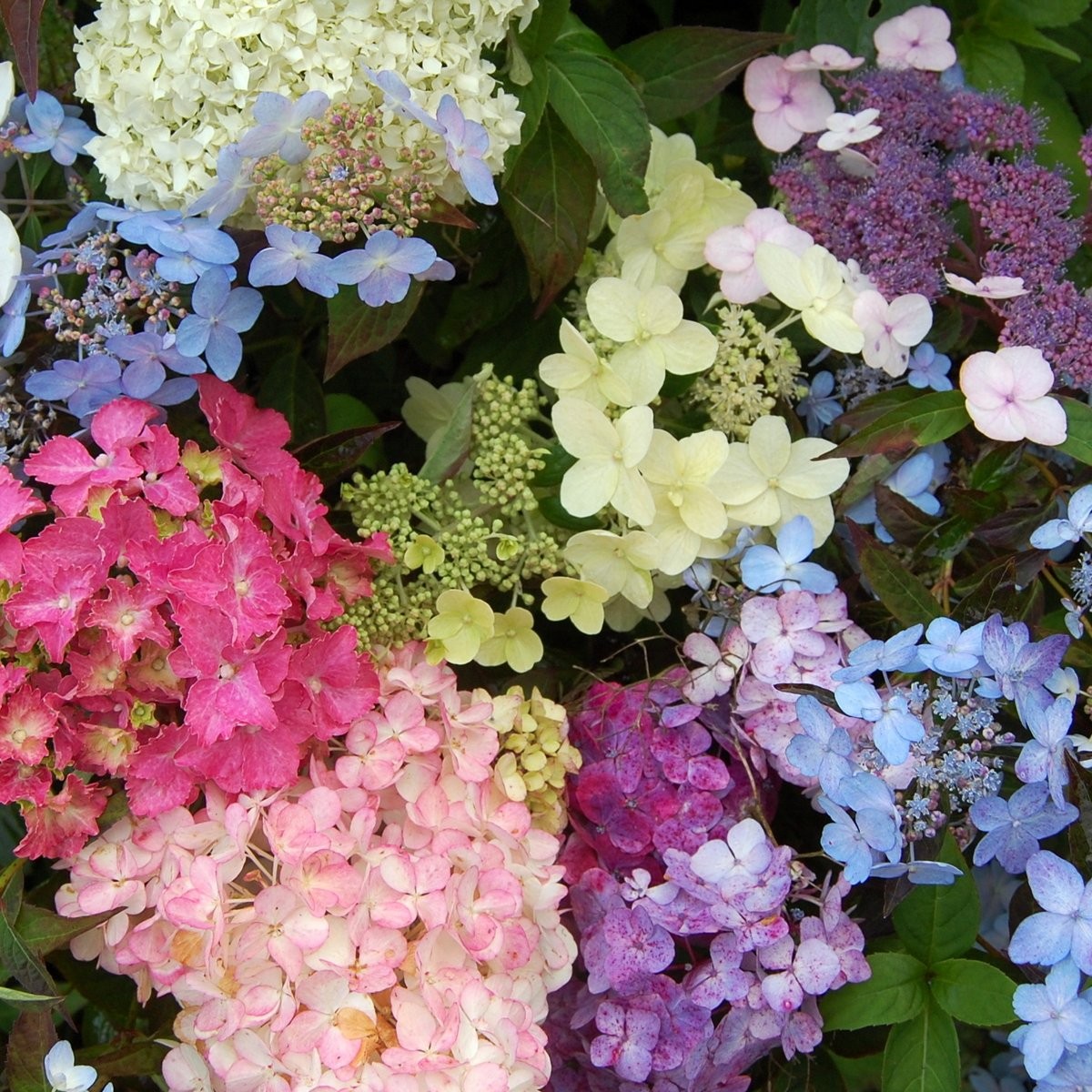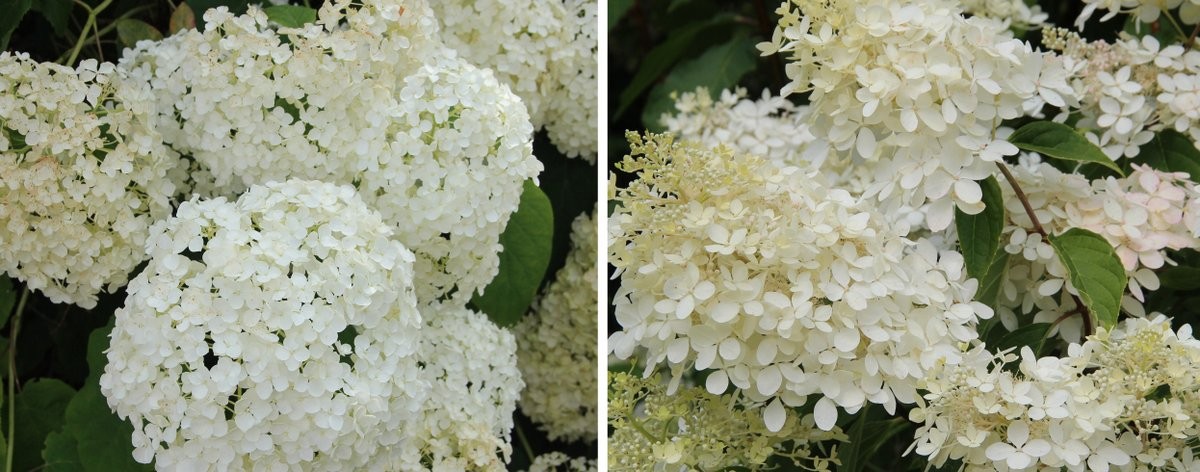
One of the best plants of all for late summer colour.
Hydrangea flower heads consist of a combination of small fertile flowers and larger more decorative flat ray florets.
Some of hybrids have ray florets which form almost the whole flower known as mopheads.
Those with a mixture of flower types are the more subtle 'lacecaps'
H3-4 (2 x 2m) Velvety leaves and striking purple fertile flowers and white-mauve sterile florets. Best in a sheltered site with wind protection. Not suitable for coldest inland gardens. It responds well to hard pruning if it gets too large or straggly.
H. sargentiana (syn. H. sargentiana) mid to late summer, large grey-green hairy leaves, flowers blue-purple, surrounded by white sterile florets,
H aspera Villosa Group (syn. H. villosa) later flowering with haunting mauve and purple shades, almost fluorescent in shade, is probably the best choice for general planting as it a little more manageable and perhaps a little hardier and does not grow so early in the season. 'Glendoick Late' is a fine form which can flower from July to November.
H3/4-5 (1.5-2 x 1.5-2m)
These is what most people have in their mind’s eye when the word hydrangea is mentioned.
Late summer flowers ranging from white, through pink to reddish and purple.
As most of Scotland has acid soil, the blue hydrangeas do tend to be blue rather than the pink or muddy pink-blue mixture which tends to occur on limey or neutral soil.
Excellent in coastal gardens; the whole Scottish western seaboard is ideal for them, and the typically peaty soil makes the blues really intense.
In eastern and inland gardens they can suffer spring frost damage from time to time, which may cause no lasting damage but it tends to reduce flowering.
The Hortensia hydrangeas divide into two groups:
H4-5 unless stated (1.5-2 x 1.5-2m)
‘Forever Pink ‘ (1x 1m) very fine pink flowers, low-growing, long flowering period.
'Merveille Sanguine' 1m purple. Leaves flushed purple. Very fine. Not vigorous.
‘Mme Emile Mouillère’ white, slightly tinted pink, one of the best of this colour.
‘Parzifal’ H3-4 deep blue.
'Zorro' H4 Black stems and mid blue flowers.
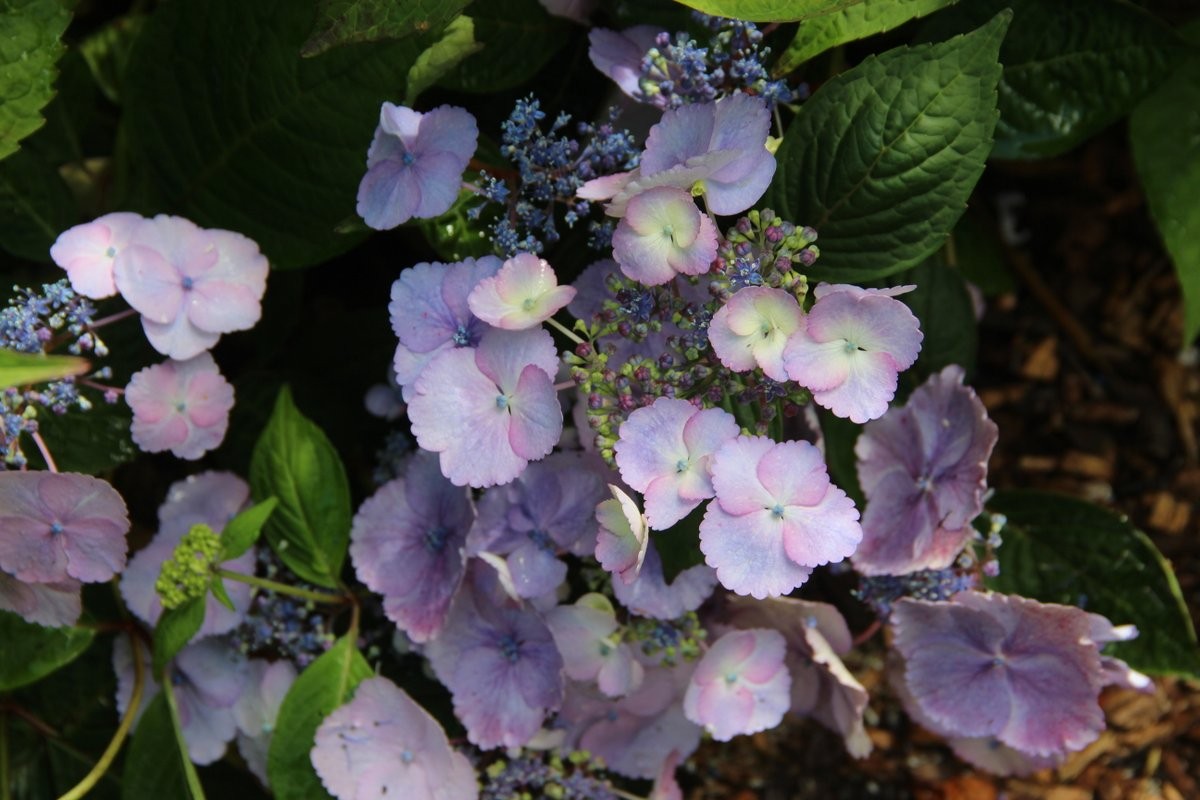
H(3)4-5 (1.5-2m in height and spread)
A mass of small flowers surrounded by sterile or ray florets, classier than the more ‘in-your-face’ mopheads.
‘Blaumeise’ (syn ‘Teller Blue’) pale blue fertile flowers, deep blue sterile florets, tough,
‘Zorro' black stems, blue flowers.
H(3)4-5 60cm-1.5m x 60cm-1m Smaller-growing, smaller leaved and sometimes hardier version of H. macrophylla and some of the best hydrangeas for Scotland are forms of this species.
‘Preziosa’ (1.5 x 1.5m) small mophead flowers which open whitish-green, turning pink to red and finally purplish, sometimes with all the colours at once with flowers at different stages, excellent in Eastern Scotland and seems pretty tough. (picture right)
‘Tiara’ intense blue in July, (pale pink in alkaline soil), small dark leaves, good autumn colour. Compact and managable. An outstanding choice.
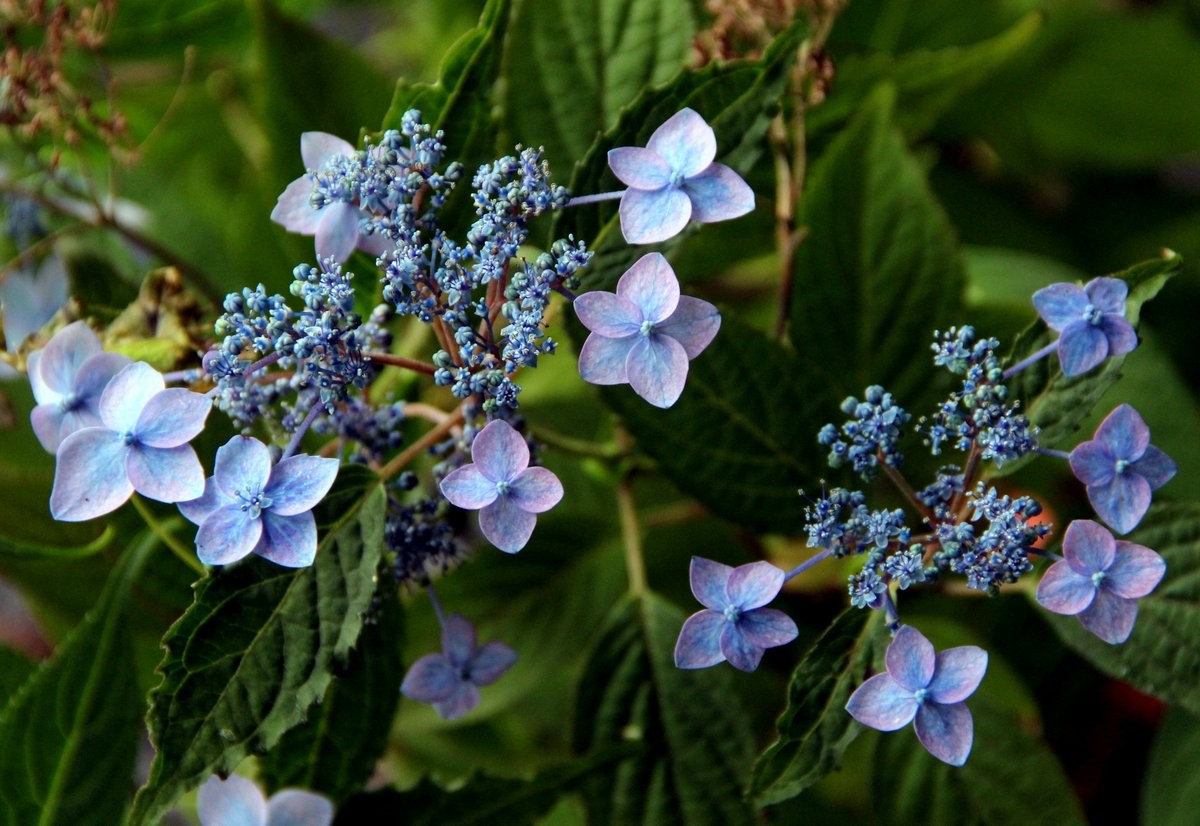
Hydrangea serrata 'Crug Cobalt'
H5 (2-3m+) The toughest and most versatile of all the hydrangeas, it will thrive the length and breadth of Scotland. The large panicles of creamy flowers open in late summer (July-August) and turn pink as they go over, hanging on into late winter. If cut back hard in spring, the flowers are larger.
| HYDRANGEA paniculata PHANTOM | The best form of this species we have seen, compact, flowering freely from a young age. Outstanding. Sells on sight. More compact than most, flowering younger. The best at Glendoick. This is the toughest Hydrangea species. Long flowering period. |
| HYDRANGEA paniculata SUNDAE FRAISE | Clusters of white flowers changing to two-toned bright pink to red. A dwarf, compact form of Vanille Fraise with equally striking flowers. |
| HYDRANGEA paniculata VANILLE FRAISE [Renhy] | Clusters of white flowers changing to two-toned bright pink to red. New French selection. This is really a head turner, the pink colour is dramatic. |
| HYDRANGEA paniculata WHITE MOTH | A Lacecap form of this species, early and subtle. White flowers changing to pink from July onwards, very pretty. Outstanding performer at RHS trials |
| HYDRANGEA quercifolia ICE CRYSTAL | White flowers turn pink, in late summer. Fine new compact selection Oak-like leaves. Good Autumn colour. Fine foliage. |
Hardiness H3-4
Size 2-3m
The SBEC form selected at Glendoick has survived -14C and is the hardiest we have seen. A vigorous summer flowering giant with lacecap white flowers in June-July.
H4-5 (1.5 x 1.5m) one of the hardiest with white flowers, suitable for cold and inland gardens. It tends to tends to die back to near ground level each year in inland and colder gardens.
'Annabelle’ Magnificent huge trusses which are so large and heavy that they to bend over the foliage. Great planted on a bank to cascade over. And looks good planted in clumps of several.
‘Discolor Sterilis’ smaller flower heads and is recommended for western gardens, as it stands rain better.
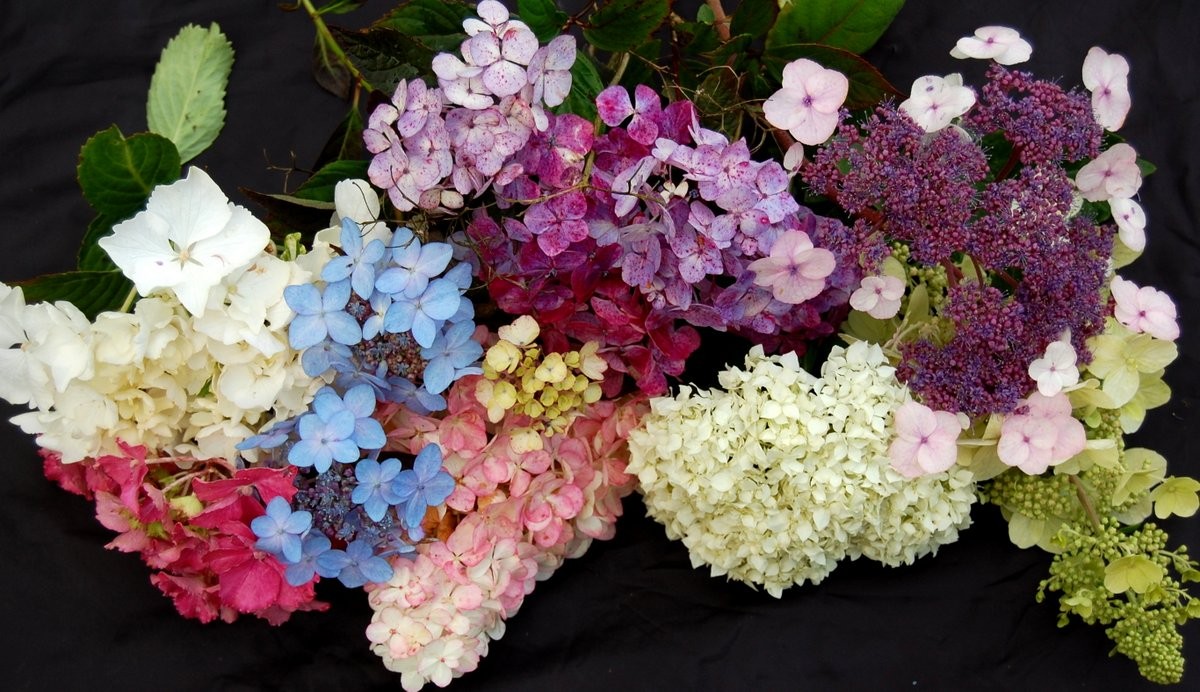
Not all hydrangeas grow or flower well in Scotland so it pays to select out the best performers. Glendoick's selection offers the best and most reliable.
Hydrangeas do not like to dry out in summer. They like moist and moisture retaining soi: so add humus from manure, compost, leaf mould, peat if possible.
Prune H. paniculata and H. arborescens in winter or early Spring
Dont prune H. macrophylla too much unless you need to reduce the size, as you will tend to prune off flower buds. If early growth is frosted wait to see where the new growth comes from. Spring frosts often means losing the flower buds.
In Scotland it is best to plant in as much sun as possible for good flowering, but sheltered from cold easterly winds. Further south more shade is OK but too much shade tends to lead to shy flowering.
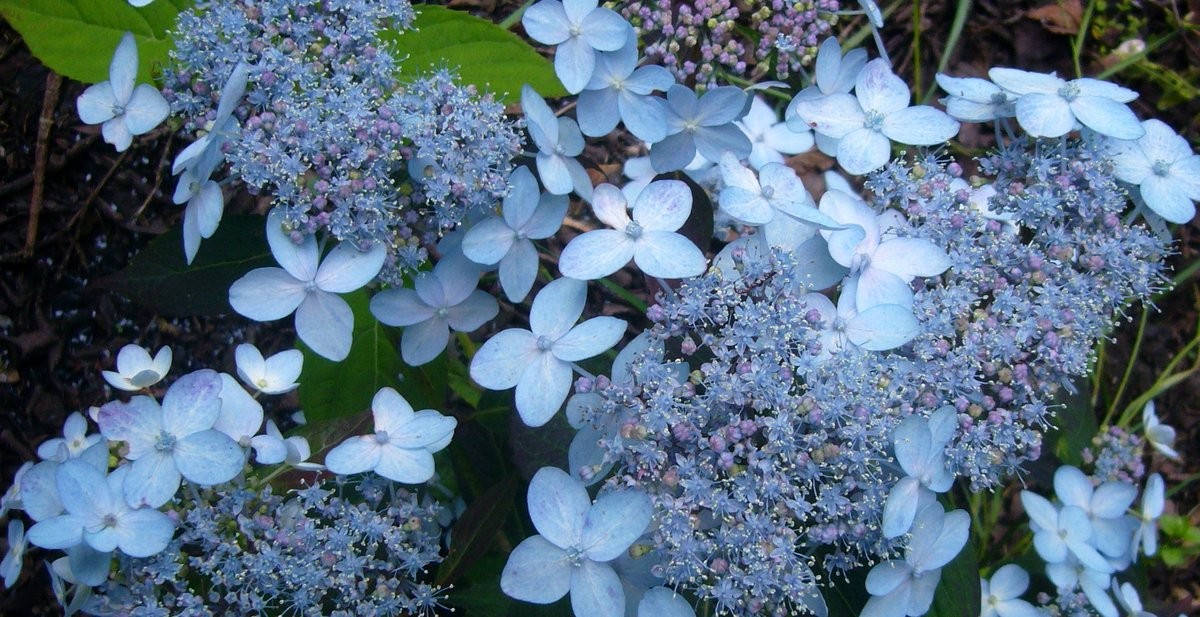
Hydrangea serrata 'Tiara' at Glendoick
